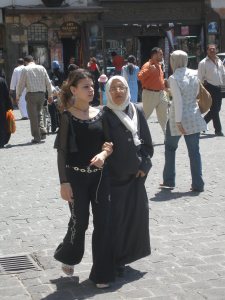#Syria’s opposition groups – do their ever-changing dynamics matter?
Arguments will rage about numbers of fighters belonging to this or that group in Syria’s opposition rebels and about who is allied to whom. But does it really matter?
Western analysts are obsessed with putting rebel groups into boxes and labelling them. Are they linked to Al Qa’ida is always the first question? Are they jihadis? What is their ideology? How Islamist are they? But it has become increasingly difficult to determine accurate numbers, as allegiances are shifting all the time, new groups are emerging or blending with others. The IHS Jane’s analyst Charles Lister thinks there are up to a thousand rebel groups who together make up a body of some 100,000 opposition fighters. He categorises only 30-40,000 of them as moderates. Other sources put the figures higher, at 120-150,000 opposition fighters, with around 50,000 of them categorised as Free Syrian Army fighters. By these sorts of reckonings something between a third and a half of the fighters are moderates, which means that something between two thirds and a half are labelled extremists.
But how meaningful are these distinctions? As more and more stories come out via journalists who spend time embedded with various rebel groups, a common thread is emerging. Many moderate fighters in the so-called extremist groups like Jabhat An-Nusra are fighting to free Syria from the Assad regime. They will join whichever group is the most effective and best-funded to achieve that end. If that means growing a beard and adopting Islamist names and slogans, so be it. There is also the important fact that these extremists groups in the north have seized much of the country’s oil, gas and grain supplies in Syria’s northeast Jezira region and can therefore distribute them to ‘loyal subjects.’ But such allegiances are temporary and are based on the economics of war. Very few such fighters and local residents are likely to remain ‘extreme Islamists’ after the objective has been achieved. The vast majority will revert to their previous moderate positions once a charade of extremism is no longer necessary.
The most interesting development of recent days has been the increasingly vocal rejection by the Syrian Coalition and by other opposition fighters inside Syria of the behaviour and ideology of ISIS, the Islamic State of Iraq and Shaam, the new extremist group which emerged in spring this year. Its summary executions, seizing of churches as military headquarters and random slaughter of anyone who is not like them are drawing more and more criticism, not just from international commentators abroad, but also from Syrian opposition figures inside and outside the country.
All these developments lead me to hope that, in some future democratic system of free elections inside Syria, Syrians will finally be free to speak out against Islamic extremism and expel it from their country. By having a taste of the reality of an ISIS-led Islamic state in areas around Aleppo and Raqqa, Syrian citizens have seen for themselves how it works on the ground.
As for the recent announcement by the 11/13 rebel groups rejecting the leadership of the Syrian Coalition in exile, that too may be less significant than it first seems. The ever-shifting dynamics among rebel groups on the ground are clearly impossible for outside powers to control, but by the same token are equally difficult for the Assad regime to control, forcing it to realise it cannot win this fight. And that makes the chances of a UN-sponsored peace agreement infinitely more hopeful than before.
Related articles
- REPORT: Nearly Half of ‘Rebel’ Fighters Jihadists, Hardline Islamists… (telegraph.co.uk)
- Extremists ‘stealing revolution’: Syria rebel chief (dailystar.com.lb)
- Syria rebel groups embrace Sharia (cnn.com)
- Nearly half of Syria’s rebels are jihadists, extremists: analysis (washingtontimes.com)
- Split Weakens U.S.-Backed Syrian Rebels as Islamists Grow (bloomberg.com)
- Syrian opposition leader Moaz al Khatib calls on Nusra to renounce al Qaida (star-telegram.com)
- Jihadists torch statues, crosses in Syria churches: NGO (dailystar.com.lb)
- http://www.joshualandis.com/blog/major-rebel-factions-drop-exiles-go-full-islamist/

ӏ treasure the content on your websites.
With thanks.
Thank you for taking the trouble to comment. I hope you will also like my forthcoming book, giving a different voice for Syria:
http://www.hauspublishing.com/product/445
http://www.wadham.ox.ac.uk/news/2014/january/a-door-to-damascus
I like readiոg through your web sites. Thanks a ton!
Thanks for your comment. The Syrian crisis needs all the attention it can get, to help people understand the situation better:
http://www.hauspublishing.com/product/445
http://www.wadham.ox.ac.uk/news/2014/january/a-door-to-damascus